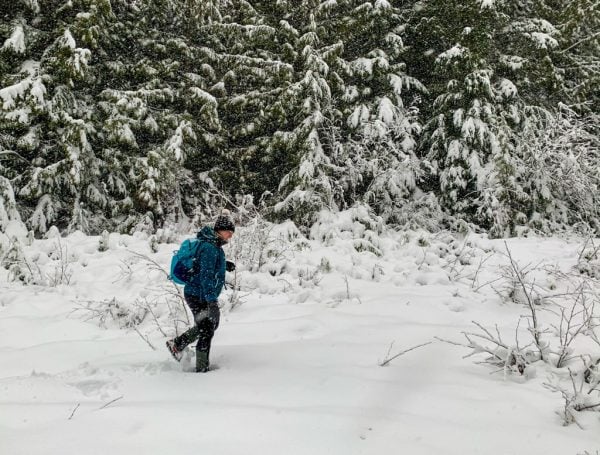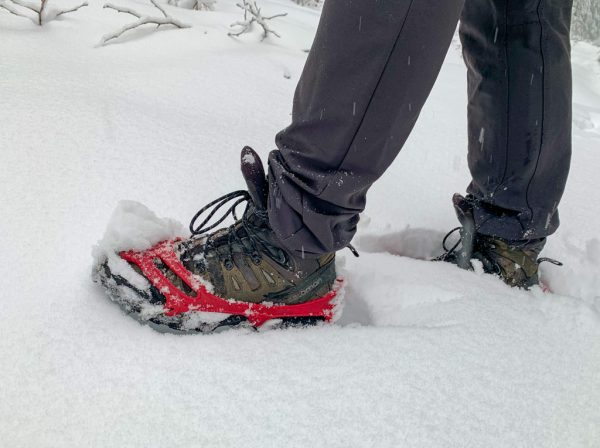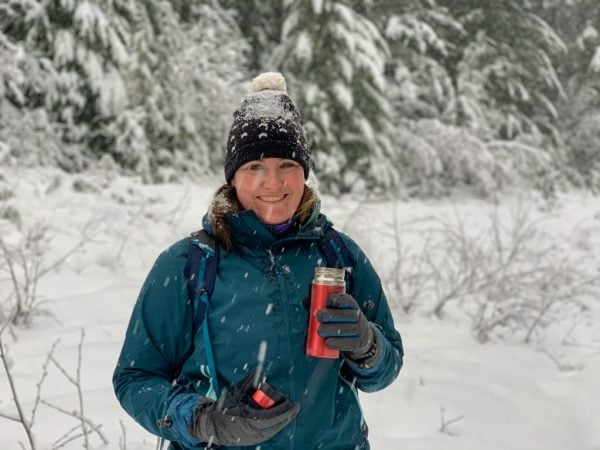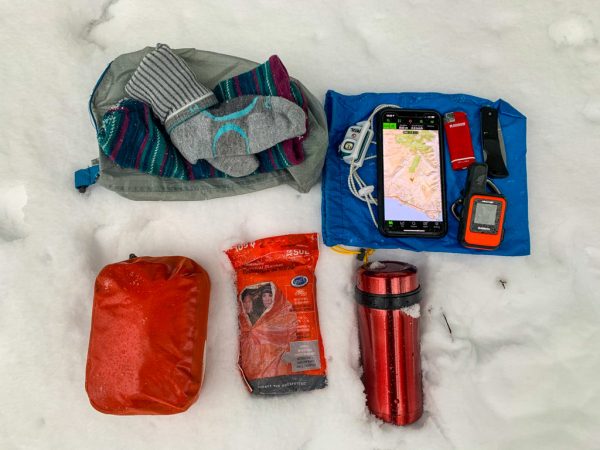What to Bring on a Winter Hike or Snowshoe Trip
Getting outdoors in the winter requires a bit more preparation than in the summer thanks to cold temperatures, unpredictable weather, and less daylight. Having the right gear can make all the difference. After nearly two decades of winter hiking and snowshoeing, here’s my advice for what to bring on a winter hike or snowshoe trip.
Layers of Clothing
Managing your body temperature is tricky in the winter since the weather is cold but you’re still working hard. Use a layered approach to stay comfortable: add and remove layers as you hike so you don’t overheat or freeze from the cold. (Try to avoid sweating as much as possible since the moisture in your clothes can cool you rapidly.)
Wear sweat-wicking wool or synthetic top and bottom base layers (a.k.a long johns), then an insulating layer like fleece or a puffy. Layer a waterproof-breathable jacket and pants over top. If you have ski pants, you can wear those instead of waterproof breathable rain pants – but be careful as their extra insulation may cause you to overheat.

Snowshoeing through deeper snow
Warm Accessories
Keeping your head and hands warm is important. While the old saying that you lose half of your body heat through your head has been debunked (it’s more like 10%), it’s still very important to insulate your head. Bring a cozy wool or synthetic toque that covers your ears.
I like to bring two pairs of gloves on all winter trips. I use a lightweight fleece pair most of the time. But I also carry a pair of extra warm and insulated ski gloves to wear if it gets really cold. A neck gaiter is also a great idea to help keep your neck, chin, and ears warm.
Warm and Waterproof Footwear
Keeping your feet dry and comfortable is key on winter trips. Choose waterproof hiking boots with good grip and consider a pair with ankle support for added stability. Thick wool or synthetic socks will add lots of warmth. If you get really cold feet, add toe warmers or heated socks. You can also buy insulated hiking boots. They have better support and fit than soft winter boots and will be more comfortable for hiking and snowshoeing. Add gaiters over top to keep the snow out.
Traction
Snow and ice are slippery! Did you know that one of the most common causes of winter hiking injuries is a slip and fall? If there is deep snow, wear your snowshoes. But if it’s hard-packed and icy, snowshoes can be a hazard as they don’t grip that well, especially on slopes. Bring a pair of microspikes, crampons, or other traction devices that attach to your shoes. Hiking poles are also really helpful for keeping your balance on steep or icy terrain.

Microspikes work well in icy conditions
Food and Drink
Snowshoeing can burn more calories than hiking, so make sure you keep yourself fueled. Bring hot drinks or use an insulated bottle to keep your water from turning to ice. Pack lots of snacks that you can eat on the go and store them inside your jacket so they don’t freeze solid.

Bring extra food and drinks as you burn more calories in the snow
Headlamp or Flashlight
Nightfall comes early in the winter. Bring a headlamp or flashlight on every trip, just in case you get caught out after dark. And of course, don’t forget extra batteries.
Extra Gear to Keep You Warm and Dry
It’s easy to get too cold in the winter. And if you get lost or have a medical emergency, you may have to wait a long time for help to arrive. Pack supplies to help you stay warm and dry no matter what. I bring an extra puffy jacket, a foil emergency blanket or bivy sack, and chemical hand warmers. A small foam butt pad is also great so you don’t get cold and wet sitting in the snow.
Wet gear can also chill you quickly. I often pack an extra pair of socks, extra gloves, and an extra toque. That way I can change into them if the original ones I was wearing get damp from snow or sweat.
Navigation
With snow obscuring trail markers, it’s easier to get lost in the winter. Bring a map and compass or use a GPS device or app. If you’re using electronics for navigation, keep in mind that cold weather kills batteries. Keep your device warm in an inside pocket, and bring a battery charger.
First-Aid Kit and Emergency Supplies
A well-stocked first-aid kit is a must-have for hikes in any season. You never know when you might need it. Check it before each trip to make sure you have restocked frequently used items like band-aids and painkillers. I also keep a pocket knife and lighter in mine, so all my emergency supplies are in one place.

Winter supplies to bring with you while snowshoeing or hiking
Sun Protection
While winter hiking often means grey skies, we do get some bluebird days in the Vancouver area. And that means you can get a wicked sunburn. (The reflection off the snow bounces the rays into some crazy places. In winter it’s possible to get a sunburn inside your nostrils!) Pack sunscreen, sunglasses, and SPF lip balm for sunny days.
Emergency Communication
Make sure you have a way to call for help, just in case. Bring your phone and an extra battery. A whistle is also a great idea as the sound carries much further than your voice. Satellite communication devices (e.g. SPOT, inReach) are a good option when you’re out of cell phone range (which is often in BC!)
Leave a Trip Plan
Thanks to snow, ice, cold temperatures, and less daylight, winter hiking and snowshoeing are riskier than summer hiking. Leaving a trip plan with a friend or family member is even more important in the winter. Make sure someone knows where you are going and when you should be back.
Taryn Eyton is a Squamish-based outdoor and adventure travel writer and Leave No Trace Master Educator. She is the founder of the hiking website HappiestOutdoors.ca and the author of Backpacking in Southwestern British Columbia: The Essential Guide to Overnight Hiking Trails (Greystone Books, 2021).

Comments that gratuitously attack or demean individuals or organizations are not acceptable. We reserve the right to remove comments or any other content we deem unacceptable in our sole discretion, including removing user names and profile pictures. For our full website terms and conditions including our legal guidelines for user postings and comments on www.vancouvertrails.com, please see our Terms of Use and Privacy Policy.